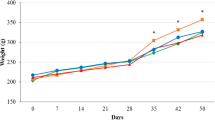Abstract
Sterol excretion in the spontaneously atherosclerosis-susceptible White Carneau (WC) pigeon, the Silver King (SK) pigeon and the Show Racer (SR) pigeon was studied by thin layer chromatography (TLC), argentation TLC and gas liquid chromatography. Unlike man and the chicken, these pigeons excreted no coprostanol or coprostanone derivatives of sterols. Moreover incubation of14C-labeled cholesterol with pigeon feces indicated that, also unlike man and the chicken, these pigeons are unable to convert it to coprostanol. Bacteriologic examination revealed the absence of gram-negative anaerobic flora and of members of the genusBifidobacterium in both the WC and SR pigeons. On the other hand, one of the two SK pigeons examined showed evidence of the presence of bothBacteroids fragilis andB. bifidum in the upper intestinal tract. Although no qualitative experiments were performed, no unusual characteristics of the aerobic flora were noted in these pigeons. In addition, analysis of human stool specimens indicated a “normal” bowel flora. The flora of the intestinal tract of the chicken is similar to that of the human. Because of this similarity, it appears that differences in environment (living conditions, diets) between the human and the chicken are of little consequence. The results obtained in this study suggest the possibility that the anaerobic gram-negative flora and sponsible, at least in part, for the chemical conversion of cholesterol to coprostanol.
Similar content being viewed by others
References
Subbiah, M.T.R., B.A. Kottke and I.A. Carlo, Mayo Clin. Proc. 45:729 (1970).
Wells, W.W., and M. Makita, Anal. Biochem. 4:204 (1962).
Eneroth, P., K. Hellström and R. Ryhage, J. Lipid Res. 5:245 (1964).
Subbiah, M.T.R., B.A. Kottke and P.E. Zollman, Comp. Biochem. Physiol. 41:695 (1972).
Rosenfeld, R.S., D.K. Fukushima, H.L. Hellman and T.F. Gallagher, J. Biol. Chem. 211:301 (1954).
Rosenfeld, R.S., and T.F. Gallagher, Steroids 4:515 (1964).
Miettinen, T.A., E.H. Ahrens, Jr., and S.M. Grundy, J. Lipid Res. 6:411 (1965).
Subbiah, M.T.R., B.A. Kottke and I.A. Carlo, Lipids 6:517 (1971).
Wood, P.D.S., and D. Hatoff, Ibid. 5:702 (1970).
Martin, W.J., Appl. Microbiol. 22:1168 (1971).
Smith, L. DS., and L.V. Holdeman, “The Pathogenic Anaerobic Bacteria,” Charles C. Thomas, Springfield, Ill., 1968, p. 423.
Willis, A.T., “Anaerobic Bacteriology in Clinical Medicine,” Butterworth & Co., London, 1960, p. 163.
Dowell, V.R., Jr., and T.M. Hawkins, “Laboratory Methods in Anaerobic Bacteriology in NCDC Laboratory Manual,” USDHEW, Public Health Service Publication 1803, Washington D.C., Government Printing Office, 1969, p. 33.
“Outline of Clinical Methods in Anaerobic Bacteriology,” Second review, Virginia Polytechnic Institute and State University Anaerobe Lab., Blacksbury Va., 1970.
Blair, J.E., E.H., Lennette and J.P. Truant, “Manual of Clinical Microbiology,” American Society for Microbiology, Bethesda, Md., 1970, p. 727.
Shields, A.B., and L. Ajello, Science 151:208 (1966).
Gorbach, S.L., Gastroenterology 60:1110 (1971).
Eggerth, A.H., and B.H. Gagnon, J. Bacteriol. 25:389 (1933).
Haenel, H., and W. Müller-Beuthow, Zentralbl. Bacteriol. (Naturwiss) 167:123 (1956).
Haenel, H., J. Appl. Bacteriol. 24:242 (1961).
Moore, W.E.C., E.P. Cato and L.V. Holdeman, J. Infect. Dis. 119:641 (1969).
Drasar, B.S., J. Pathol. Bacteriol. 94:417 (1967).
Finegold, S.M., and L.G. Miller, Amer. Soc. Microbiol. (Bacteriol. Proc.) 1968:93.
Finegold, S.M., D.J. Posnick, L.G. Miller and W.L. Hewitt, Ernahrungsforschung 10:316 (1965).
Dam, H., Biochem. J. 28:515 (1934).
Snog-Kjaer, A., I. Prange and H. Dam, J. Gen. Microbiol. 14:256 (1956).
Coleman, D.L., and C.A. Baumann, Arch. Biochem. Biophys. 72:219 (1957).
Author information
Authors and Affiliations
Additional information
The following nomenclature has been used for the steroids referred to in this paper: cholesterol, cholest-Δ5-en-3β-ol; coprostanol, 5β-cholestan-3β-ol; campesterol, 24-methylcholest-Δ5-en-3βol; stigmasterol, 24-ethylcholest-Δ5,22-dien-3β-ol; β-sitosterol, 24-ethylcholest-Δ5-en-3β-ol; coprocampestanol, 24-methyl-5β-cholestan-3β-ol; coprostigmastenol, 24-ethyl-5β-cholest-Δ22-en-3β-ol; coprostigmastanol, 24-ethyl-5β-cholestan-3β-ol; coprostanone, 5β-cholestan-3-one; campestanone, 24-methyl-5β-cholestan-3-one; stigmastenone, 24-ethyl-5β-cholest-Δ22-en-3-one; and β-sitostanone, 24-ethyl-5β-cholestan-3-one.
About this article
Cite this article
Martin, W.J., Ravi Subbiah, M.T., Kottke, B.A. et al. Nature of fecal sterols and intestinal bacterial flora. Lipids 8, 208–215 (1973). https://doi.org/10.1007/BF02544637
Received:
Issue Date:
DOI: https://doi.org/10.1007/BF02544637




